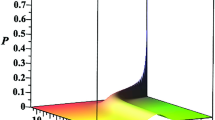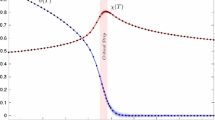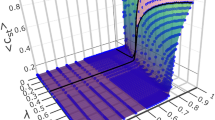Abstract
We develop a thermodynamic formalism for a dissipative version of the Zhang model of Self-Organized Criticality, where a parameter allows us to tune the local energy dissipation. By constructing a suitable Markov partition we define Gibbs measures (in the sense of Sinai, Ruelle, and Bowen), partition functions, and topological pressure allowing the analysis of probability distributions of avalanches. We discuss the infinite-size limit in this setting. In particular, we show that a Lee–Yang phenomenon occurs in the conservative case. This suggests new connections to classical critical phenomena.
Similar content being viewed by others
References
P. Bak, C. Tang, and K. Wiesenfeld, Self organized criticality: An explanation of 1/f noise, Phys. Rev. Lett. 59:381–384 (1987); P. Bak, C. Tang, and K. WiesenfeldSelf organized criticality, Phys. Rev. A. 38: 364–374 (1988).
P. Bak, How Nature Works (Springer-Verlag, 1996).
H. J. Jensen, Self-organized criticality: Emergent complex behavior in physical and biological systems, in Cambridge Lecture Notes in Physics, Vol. 10 (Cambridge University Press, 1998).
D. H. Meyer, The Ruelle–Araki transfer operator in classical statistical mechanics, Lecture Notes in Physik, Vol. 123 (Springer-Verlag).
D. Ruelle, Statistical Mechanics: Rigorous Results (Benjamin, New York, 1969).
C. N. Yang and T. D. Lee, Statistical theory of equations of state and phase transitions I. Theory of condensation, Phys. Rev. 87:404–409 (1952); C. N. Yang and T. D. LeeStatistical theory of equations of state and phase transitions II. Lattice gas and Ising model, Phys. Rev. 87:410–419 (1952).
R. Abe, Note on the critical behavior of Ising ferromagnets, Prog. Theor. Phys. 38(1967)
M. J. Fisher, The renormalization group in the theory of critical behaviour, Rev. Mod. Phys. 46:597–616 (1974).
C. Itzykson, R. B. Pearson, and J. B. Zuber, Distribution of zeros in Ising and Gauge models, Nuclear Phys. B 220[FS8]:415–433 (1983).
M. L. Glasser, V. Privman, and L. S. Schulman, Complex-temperature-plane zeros: Scaling theory and multicritical mean-field models, Phys. Rev. B 33(1987).
W. Janke and R. Kenna, The strength of first and second order phase transitions from partition function zeros, J. Stat. Phys. 102:1221–1227 (2001).
R. J. Creswick and S. Y. Kim, Finite-size scaling of the density of zeros of the partition function in first and second order transitions, Phys. Rev. E 56:2418(1997).
L. P. Kadanoff, S. R. Nagel, L. Wu, and S. Zhou, Scaling and universality in avalanches, Phys. Rev. A 39:6524–6527 (1989).
C. Tebaldi, M. De Menech, and A. Stella, Phys. Rev. Lett. 83:3952(1999).
R. Pastor-Satorras and A. Vespignani, Anomalous scaling in the Zhang model, Eur. Phys. J. B 18:197–200 (2000)
Ph. Blanchard, B. Cessac, and T. Krüger, A dynamical systems approach for SOC models of Zhang type, J. Stat. Phys. 88:307–318 (1997).
B. Cessac, Ph. Blanchard, and T. Krueger, A dynamical system approach to self-organized criticality, in Mathematical Results in Statistical Mechanics, Marseille 1998 (Word Scientific, Singapore).
Ph. Blanchard, B. Cessac, and T. Krüger, What can one learn about self-organized criticality from dynamical system theory ?, J. Stat. Phys. 98:375–404 (2000).
B. Cessac, Ph. Blanchard, and T. Krüger, Lyapunov exponents and transport in the Zhang model of self-organized criticality, Phys. Rev. E 64:016133(2001).
H. Y. Zhang, Scaling theory of self-organized criticality, Phys. Rev. Lett. 63:470–473 (1988).
Ya. G. Sinai, Gibbs measures in ergodic theory, Russ. Math. Surveys 27:21–69 (1972)
D. Ruelle, Thermodynamic Formalism (Addison–Wesley, Reading, MA, 1978).
R. Bowen, Equilibrium states and the ergodic theory of Anosov diffeomorphisms, Lect. Notes in Math., Vol. 470 (Springer-Verlag, Berlin, 1975).
B. Cessac and J. L. Meunier, Anomalous scaling and Lee–Yang zeroes in self-organized criticality, Phys. Rev. E 65:1–18 (2002).
D. Dhar, Phys. Rev. Lett. 64:1613(1990); D. Dhar and S. N. Majumdar, J. Phys. A 23:4333(1990); S. N. Majumdar and D. Dhar, Physica A 185:129(1992); D. Dhar and R. Ramaswamy, Phys. Rev. Lett. 63:1659(1989).
D. Sornette, A. Johansen, and I. Dornic, Mapping self-organized criticality onto criticality, J. Phys. France 5:325–335 (1995).
G. Keller, Equilibrium States in Ergodic Theory (Cambridge University Press, 1998).
A. Katok and B. Hasselblatt, Introduction to Dynamical Systems Theory (Kluwer, 1996).
A. Vespignani and S. Zapperi, How self-organized criticality works: A unified mean-field picture, Phys. Rev. E 57:6345(1998).
V. I. Oseledec, A multiplicative ergodic theorem. Characteristic Lyapunov exponents of dynamical systems, Trans. Moscow Math. Soc. 19:179–210 (1968).
M. Pollicott, Lectures on ergodic theory and Pesin theory on compact manifolds, London Math. Soc., Lect. Notes Series, Vol. 180 (Cambridge University Press, 1993).
J. P. Eckmann and D. Ruelle, Ergodic theory of strange attractors, Rev. Mod. Phys. 57:617(1985); J. P. Eckmann, O. Kamphorst, D. Ruelle, and S. Cilliberto, Phys. Rev. A 34:4971(1986).
Eurandom conference, Longe Range Stochastic Dynamics, Eindhoven, December 2001.
Ph. Flajolet, Theoretical Computer Sci. 215:371–381 (1999).
E. Seneta, Non-Negative Matrices (Allen and Unwin, London, 1973).
D. Volchenkov, Ph. Blanchard, and B. Cessac, Quantum field theory renormalization group approach to self-organized criticality: The case of random boundaries, Int. J. Mod. Phys. B 16:1171–1204 (2002).
L. Pietronero, A. Vespignani, and S. Zapperi, Phys. Rev. Lett. 72:1690(1994); A. Vespignani, S. Zapperi, and L. Pietronero, Phys. Rev. E. 51:1711(1995).
K. Falconer, Techniques in Fractal Geometry (Wiley, 1997).
Ph. Blanchard, B. Cessac, and S. Sequeira, in preparation.
K. J. Falconer, Bounded distortion and dimension for non-conformal repellers, Math. Proc. Camb. Phil. Soc. 115:315–334 (1994).
L. M. Barreira, A non-additive thermodynamic formalism and applications to dimension theory of hyperbolic dynamical systems, Ergod. Theor. Dynam. Syst. 16:871–927 (1998).
K. J. Falconer, Generalized dimensions of measures on self-affine sets, Nonlinearity 12:877–891 (1999).
M. Benaim and N. E. Karoui, Promenades aléatoires, Cours de l'école polytechnique.
B. Dorfmann, An Introduction to Chaos in Nonequilibrium Statistical Mechanics (Cambridge University Press, 1999).
P. Gaspard, Chaos, scattering, and statistical mechanics, in Cambridge Nonlinear Science, Series 9 (Cambridge University Press, Cambridge, 1998).
C. Beck and F. Schloegl, Thermodynamics of chaotic systems, in Cambridge Nonlinear Science, Series 4 (Cambridge University Press, Cambridge, 1993).
P. Bak and C. Tang, Critical exponents and scaling relations for self-organized critical phenomena, Phys. Rev. Lett. 60:2347–2350, (1988).
W. Parry and M. Pollicott, Zeta functions and the periodic orbit structure of hyperbolic dynamics, Collection Asterisque (Société Mathématique de France, 1990), pp. 187–188.
A. Barrat, A. Vespignani, and S. Zapperi, Fluctuations and correlations in sandpile models, Phys. Rev. Lett. 83:1962(1999).
F. Ledrappier and L. S. Young, The metric entropy for diffeomorphisms, Ann. Math. 122:509–574 (1985).
O. M. Sarig, Thermodynamic formalism for countable markov shifts, Ergod. Th. Dyn. Sys. 19:1565–1593 (1999).
L. S. Young, Ergodic theory of differentiable dynamical systems.
C. Maes, F. Redig, E. Saada, and A. Van Moffaert, On the thermodynamic limit for a one-dimensional sandpile process, Markov Process. Related Fields 6:1–21 (2000).
Author information
Authors and Affiliations
Rights and permissions
About this article
Cite this article
Cessac, B., Blanchard, P., Krüger, T. et al. Self-Organized Criticality and Thermodynamic Formalism. Journal of Statistical Physics 115, 1283–1326 (2004). https://doi.org/10.1023/B:JOSS.0000028057.16662.89
Issue Date:
DOI: https://doi.org/10.1023/B:JOSS.0000028057.16662.89




